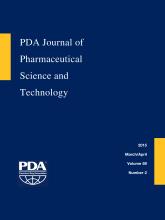Research ArticleResearch
Studies of Protein Oxidation as a Product Quality Attribute on a Scale-Down Model for Cell Culture Process Development
Nacole D. Lee, Bhargavi Kondragunta, Shaunak Uplekar, Jose Vallejos, Antonio Moreira and Govind Rao
PDA Journal of Pharmaceutical Science and Technology March 2015, 69 (2) 236-247; DOI: https://doi.org/10.5731/pdajpst.2015.01035
Nacole D. Lee
1Department of Biomedical Sciences, Hood College, Frederick, MD; Currently at MedImmune, Inc., Gaithersburg, MD;
Bhargavi Kondragunta
2Center for Advanced Sensor Technology and Department of Chemical, Biochemical and Environmental Engineering; University of Maryland, Baltimore County; Baltimore, MD;
3Currently at Vaccine Research Center, NIH; and
Shaunak Uplekar
2Center for Advanced Sensor Technology and Department of Chemical, Biochemical and Environmental Engineering; University of Maryland, Baltimore County; Baltimore, MD;
Jose Vallejos
2Center for Advanced Sensor Technology and Department of Chemical, Biochemical and Environmental Engineering; University of Maryland, Baltimore County; Baltimore, MD;
4Currently at MS&T-AstraZeneca, Frederick, MD
Antonio Moreira
2Center for Advanced Sensor Technology and Department of Chemical, Biochemical and Environmental Engineering; University of Maryland, Baltimore County; Baltimore, MD;
Govind Rao
2Center for Advanced Sensor Technology and Department of Chemical, Biochemical and Environmental Engineering; University of Maryland, Baltimore County; Baltimore, MD;

References
- 1.↵
- Li F.,
- Zhou J.,
- Yang X.,
- Tressel T.,
- Lee B.
- 2.↵
- Goochee C. F.,
- Monica T.
- 3.↵
- Konz J.,
- King J.,
- Cooney C.
- 4.↵
- Quiang L.,
- Harvey L.,
- McNeil B.
- 5.↵
- Yang J.,
- Lu C.,
- Stansy B.,
- Henley J.,
- Guinto W.,
- Gonzalez C.,
- Gleason J.,
- Fung M.,
- Collopy B.,
- Benjamino M.,
- Gangi J.,
- Hanson M.,
- Ille E.
- 6.↵
- Brorson K.,
- de Wit C.,
- Hamilton E.,
- Mustafa M.,
- Swann PG.,
- Kiss R.,
- Taticek R.,
- Polastri G.,
- Stein K. E.,
- Xu Y.
- 7.↵
- Meuwly F.,
- Weber U.,
- Ziefler T.,
- Gervais A.,
- Mastrangeli R.,
- Crisci C.,
- Rossi M.,
- Bernard A.,
- von Stockar U.,
- Kadouri A.
- 8.↵
Kondragunta et al. 2012.
- 9.↵
- Naciri M.,
- Kuystermans D.,
- Al-Rubeai M.
- 10.↵
- Eichhorn L. R.,
- Bartlett R. A.,
- Frey D. D.,
- Rao G.
- 11.↵
- Dhir S.,
- Morrow K. J.,
- Rhinehart R. R.,
- Wesner T.
- 12.↵
- Dasari V.,
- Rao K.,
- Ramu C.,
- Rao J.,
- Narasu M.,
- Rao A.
- 13.↵
- Magi B.,
- Ettorre A.,
- Liveratori S.,
- Bini L.,
- Andreassi M.,
- Frosali S.,
- Neri P.,
- Pallini V.,
- Di Stefano A.
- 14.↵
- Shacter E.
- 15.↵
- Soreghan B.,
- Yang F.,
- Thomas S.,
- Hsu J.,
- Yang A.
- 16.↵
- Dalle-Donne I.,
- Rossi R.,
- Giustarini D.,
- Milzani A.,
- Colombo R.
- 17.↵
- Buss I. H.,
- Chan T. P.,
- Sluis K. B.,
- Domigan N. M.,
- Winterbourn C. C.
- 18.↵
- Vallejos J.,
- Brorson K.,
- Moreira A.,
- Rao G.
- 19.↵
- Riet K.
- 20.↵
- Kostov Y.,
- Harns P.,
- Randers-Eichhorn L.,
- Rao G.
- 21.↵
- Stadtman E. R.
- 22.↵
- Saarinem M.,
- Murhammer D. W.
In This Issue
PDA Journal of Pharmaceutical Science and Technology
Vol. 69, Issue 2
March/April 2015
Studies of Protein Oxidation as a Product Quality Attribute on a Scale-Down Model for Cell Culture Process Development
Nacole D. Lee, Bhargavi Kondragunta, Shaunak Uplekar, Jose Vallejos, Antonio Moreira, Govind Rao
PDA Journal of Pharmaceutical Science and Technology Mar 2015, 69 (2) 236-247; DOI: 10.5731/pdajpst.2015.01035
Jump to section
Related Articles
- No related articles found.
Cited By...
- No citing articles found.





